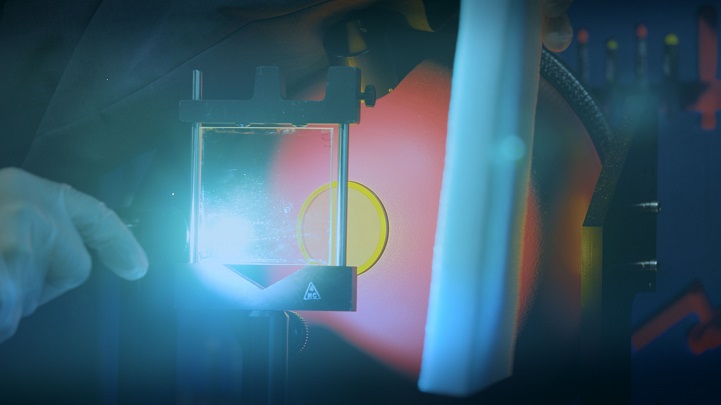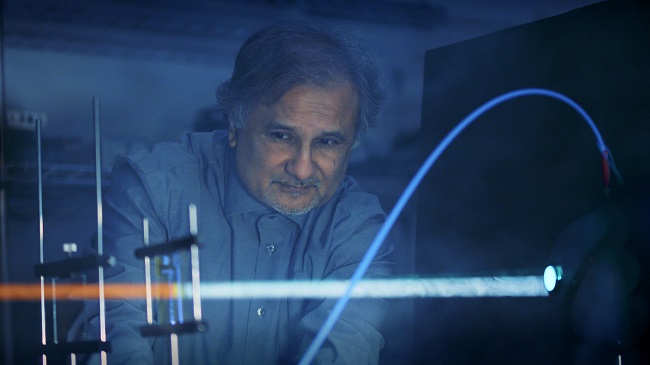SunDensity, a developer of photonic smart coatings (PSC) technology, has earned $1 million in funding as the winner of the third cohort of the Luminate NY Program’s Innovation Finals Competition. All Luminate third-cohort winners, highlighted by program winner and Luminate “Company of the Year” SunDensity, were announced during the accelerator’s virtual finals competition on the first day of The Optical Society’s (OSA) Frontiers in Optics + Laser Science Conference (FiO + LS).
New York state, through the Finger Lakes Forward Upstate Revitalization Initiative, will provide the $1 million award. SunDensity, which formed in Boston, will locate its operations and manufacturing in Rochester, N.Y.
SunDensity President and CEO Nishikant “Nish” Sonwalkar pitched and outlined his company’s program-winning technology as part of Monday’s finals session. The PSC reacts to incoming photons and shapes the outgoing photons to maximize their amenability to optoelectronic devices, such as solar cells. SunDensity’s PSC contains multiple nano-optical layers that selectively downshift ultraviolet photons into the infrared, creating a quantum match and generating a higher number of electrons.
“Our company is on a mission to make solar power have parity with the electricity grid, which will accelerate clean energy adoption,” Sonwalkar said. When applied to solar photovoltaic (PV) panels, the coating increases clean energy production, significantly reducing carbon emissions.
SunDensity PSC technology, Sonwalkar said, increases the efficiency of existing solar panels by full five percent taking a solar cell with efficiency of 22% to operate at 27% efficiency%, which corresponds to an increase of approximately 15-20% in power output.
In addition to increasing panel output, and unlike conventional antireflection (AR) coatings, SunDensity’s PSC also decreases the levelized cost of energy (LCOE) by producing more power per panel.
The company’s PSC can also be applied to glass surfaces such as architectural windows and digital imaging platforms such as night vision cameras and CCDs to increase digital camera responsivity. Nano-optical smart coating supports “smart window” technology, which can retain thermal energy when desirable and also let heat escape.

SunDensity can enhance the energy output of solar panels by 20% with its photonic smart coating (PSC). PSC improves the efficiency of opto-electronic devices such as solar cells by enhancing and shaping the spectrum of photons, transforming wasted visible light into infrared light that many devices can more easily use. Courtesy of Luminate.
Sonwalkar formed SunDensity in 2016. As a participant of the Luminate program and as a National Science Foundation’s SBIR funded company, SunDensity has used the cleanroom, or clean fabrication area at the URNano at University of Rochester to develop its coatings, and has shifted many facets of its operation to Rochester, a city Sonwalkar called the “photonics capital of the country.” Sonwalkar said the company is now entering a crucial scale-up process, supported by Luminate and NSF funding and the company’s ties to the Rochester optics and photonics community, to meet the manufacturing demands of the solar industry. Specifically, its Luminate award and training will help the company to attract significant venture funds in the cleantech area, Sonwalkar said.
“We are situated within a great photonics knowledge base and workforce that we will employ to grow our company,” Sonwalkar said. “We need a trained workforce in photonics and optics, and that is the strength of Rochester. The facilities and price point for setting up a manufacturing line in the region are excellent.
“Manufacturing now becomes the challenge — developing a highly scalable manufacturing process to see if we can meet industry requirements and growing demand” Sonwalkar said. SunDensity plans to open its own lab and pilot coating line in the next 8 to 12 months.
“We are really delighted to win this award. With this support, SunDensity is on its way to great success in New York state and beyond.”
“Luminate NY's strategic investments in these emerging companies have upheld New York as a worldwide leader in optics, photonics, and imaging,” New York Gov. Andrew Cuomo said in a press release following Monday’s live event.
“I congratulate SunDensity on winning round 3 of the innovative Luminate NY competition and look forward to the company contributing to the growth of our region's OPI industry, which will continue to help move the Finger Lakes economy forward.”
The Luminate Finals 2020 marked the halfway point of the five-year Luminate accelerator program. Since its inception, it has invested $7 million in 30 startups. The companies in the portfolio now share a net worth of $160 million.

SunDensity founder and CEO Nishikant 'Nish' Sonwalkar. Courtesy of Luminate.
“The Luminate Finals Competition added a level of excitement to the combined FiO + LS and Quantum 2.0 Conferences that captivated attendees from across the globe,” OSA CEO Elizabeth Rogan said. “This accelerator program will continue to inspire innovation and encourage the optics, photonics, and imaging community to rally behind early-stage companies with groundbreaking technologies.”
Rochester-based Simulated Inanimate Models (SIM) was awarded the “Outstanding Graduate Award” and is receiving $400,000 in funding; its technology, SIM ARTS, offers an immersive “flight simulator for surgery” that eliminates patient risk by enabling surgeons to practice complete procedures on lifelike anatomical models in an augmented reality environment that does not require the presence of the expert instructing surgeon. Rubitection, based in Pittsburgh, won the “Distinguished Graduate Award” and $300,000 in funding for its Rubitect Assessment System (RAS), which provides early bedsore detection and management tools.
AkknaTek, which provides an optical imaging system that reduces post-operative refractive surprises after cataract surgery, and Nodetect, developers of a portable, rapid nanosensor for analyzing biochemicals in agriculture, each earned “Honorable Achievements” and $250,000 in funding.
More than 800 attendees at the event also had an opportunity to vote for their favorite company. The “Audience Choice” award for $10,000 went to Kilo Medical Solutions. Kilo is a medical startup that has developed a product that can be hooked up to incubators to control lighting for infants in neonatal ICUs.
In addition to its influence on the Rochester optics and photonics community, now halfway through the program, the accelerator is supporting a wider, international optics and photonics community.
“We have been very fortunate to have the support of the international optics/photonics community,” Sujatha Ramanujan, Luminate NY managing director, told Photonics Media before the Finals Competition.
“This program is seen as helping the industry as a whole and not just regionally. The companies are also engaging manufacturing partners and mentors from the industry and embedding and growing with them. The acceptance is reflected in the record number of international participants looking to gain a foothold in the U.S.”
Funding for the $25 million, five-year Luminate NY program is being provided through Empire State Development and the transformative Finger Lakes Forward Upstate Revitalization Initiative, which aims to draw OPI industries to the Finger Lakes region.
The Luminate NY accelerator selects 10 companies annually to participate in its six-month program. Luminate is accepting round four applications through Jan. 7, 2021.